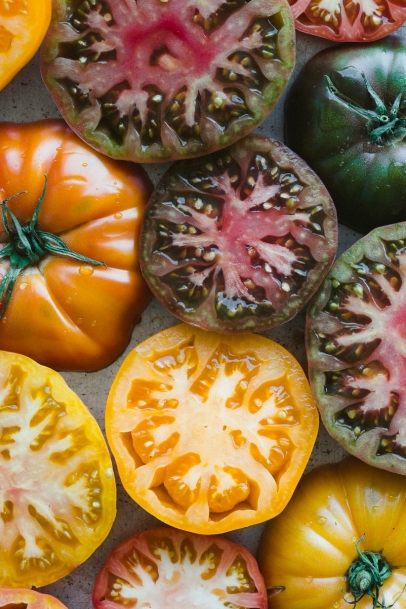A Taste of Summer
Nothing speaks more of summer’s bounty than a humble farm stand’s display of colorful, succulent tomatoes, a sight that prompts our taste buds to hum a happy tune. Often we are drawn to those that are symmetrically shaped and blemish-free, their picture-perfect looks making us think that they are indeed the “real deal.” Frequently found sitting next to this handsome group is a variety called the “heirloom,” which, because of its irregular shape, may be easily dismissed as a less than acceptable option. Don’t let appearances deceive you, heirlooms are indeed one of summer’s most mouthwatering delights.
Heirloom tomatoes are grown from seeds that have been passed down from generation to generation. Ordinarily, these seeds are at least 50 years old, having been hand-selected by farmers for a special trait. They are open-pollinated, meaning by insects or wind, not human hands. In the late 1980s and early 1990s, the advent of the farm-to-table movement brought heirlooms to the attention of consumers and food writers. Heirloom tomatoes have become more popular in recent years because shoppers have discovered that they have a greater flavor than the hybrid variety. Hybrids, which are bred for their commercially attractive, uni- form appearance, often fall short when it comes to flavor. These are the tomatoes that are available year round at local grocery stores.
Worldwide, more than 3,000 varieties of heirloom tomatoes are actively being cultivated. In seed catalogs the number of offerings are much more limited. Intriguing names such as Yellow Brandywine, Cherokee Purple, Ruby Gold, Green Zebra and Brown Derby are well known to gardeners. Heirlooms range in size from the Mexico Midget tomato, which is said to be the smallest and is the size of a blueberry, to the Mortgage Lifter, one of the largest, weighing in at two pounds or more. Brandywine tomatoes are an example of an heirloom beefsteak tomato. In this case, “beefsteak” means a type of tomato that is as meaty as a steak and contains few seeds. The Rutgers heirloom, introduced in 1934, is good for canning. For the home gardener there are many options to choose from.
Heirloom tomatoes offer a diversity of flavor and color. Interestingly, there is no correlation between a tomato’s color and its flavor, and each variety may have its own unique taste. It is hard to determine the ripeness of blacks, or those with purple or brown tones. The best way to verify a tomato’s ripeness is to give a gentle squeeze: It should feel soft to the touch, but not squishy. Surprisingly, heirlooms that are sold at grocery stores are not always locally grown. It is wise to remember that the farther your tomatoes have to travel, the less flavorful they will be. The best bet is to visit a local farm stand or farmers’ market, to find just-picked flavor.
Although a farm’s selection of heirlooms may not fit most people’s precon- ceived notion of the perfect tomato, remember an irregular shape and mottled skin will not impact taste. Don’t be deterred by a tomato with cracked skin; as long as your choice is not leaking juice, it is perfectly fine and just as tasty as its unblemished partners. Choose those that feel heavy for their size. Take a whiff, too. A ripe heirloom should give off an earthy odor, but avoid those that have a musty aroma, for they have more than likely passed their prime. Treat your heir- looms with kid gloves since piling tomatoes on top of each other when bagging may squash those that are softer. If you are the lucky recipient of some of your neighbor’s green tomatoes, be sure to keep them stem-side down in a paper bag or cardboard box arranged in a single layer. Always store your tomatoes in a cool place away from sunlight. There are conflicting opinions concerning refrigerating tomatoes. I lean toward keeping mine at room temperature as it seems to preserve the flavor.
Heirlooms tomatoes cost a bit more than their hybrid relatives, but they are well worth the extra cost. Heirloom tomatoes are all about flavor, color and texture. I love slicing into one of these delicious treasures and reveling in its sweet, rich flavor—truly, a taste of summer!
Tracey Medeiros keeps it local and seasonal in her kitchen.







